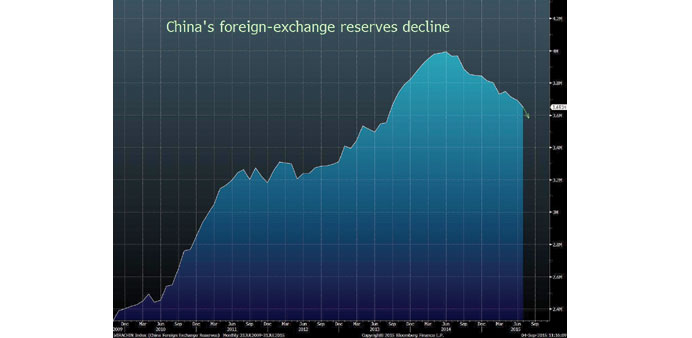Bloomberg
Beijing
When the US’s biggest foreign creditor sells Treasuries, the world takes notice.
The People’s Bank of China will probably report as soon as today that its foreign reserves shrank about $71bn last month to $3.58tn, according to the median estimate in a Bloomberg survey of economists. About a third of the war chest is in Treasuries, making China the largest overseas holder.
The latest figures will give investors a rough gauge of how much US government debt the Chinese central bank may have liquidated as part of supporting its currency last month and staunching capital outflows following its shock devaluation of the yuan on August 11.
The Treasuries sales are feeding speculation among traders that US yields would’ve fallen even further amid worldwide flight-to-quality buying last month during the swoon in stocks.
The benchmark 10-year yield, which dropped below 2% on August 24 for the first time since April, was at 2.12% on Friday.
Long-term Treasuries gained on Friday, benefiting from a tumble in stocks after Labour Department data showed the US unemployment rate fell in August to the lowest since April 2008, while the nation added fewer jobs than forecast.
Analysts from Barclays and Societe Generale forecast an even deeper drop in China’s reserves than the median projection in Bloomberg’s survey. Each bank expects the decline to exceed $100bn, which would be the biggest monthly draw-down since at least 1996.
China’s reserves more than tripled in the past decade as the nation’s central bank bought dollars to slow the yuan’s appreciation amid a swelling trade surplus. The PBoC holds almost a third of the world’s reserves.
Investors are paying more attention to China’s use of those assets since the yuan devaluation. The central bank’s buying of yuan and selling of dollars drains liquidity and puts a brake on the world’s second-biggest economy.
“The PBoC appeared to be heavily active in the spot market after the currency regime change on August 11 in order to stabilise the yuan,” Wei Yao, a Paris-based China economist at Societe Generale, wrote in a research report on September 3. “We think that $1tn is the absolute maximum the PBoC can sell.” The central bank started to report monthly reserve data in August, though there’s no set schedule.
Excluding the effect of exchange-rate fluctuations, the PBoC may reduce reserves by as much as 14% from June to December, according to Barclays. To replenish liquidity, the central bank may lower the reserve requirement ratio for domestic financial institutions by 40 basis points, or 0.4 percentage point, a month, following the 50 basis-point reduction to 18% late last month, Barclays estimates.“We do not believe the present policy is sustainable given the associated costs in terms of foreign-exchange reserves depletion and liquidity imbalances,” Mitul Kotecha, head of Asia Pacific currency strategy at Barclays in Singapore, wrote in a note September 3.



